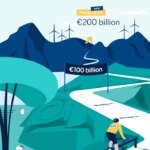What is sustainable financing and how is it regulated?
With increasing frequency, Governments and financial and non-financial organizations are relying on the so-called sustainable finance instruments to fund projects intended to create a positive impact on the environment - such as the development of eco-friendly energy sources - and promote social and inclusive growth. In Spain, sustainable finance mobilized a total of €33.03 billion in 2020, according to data from the Spanish Observatory for Sustainable Financing (OFISO).

Sustainable finance is already shaping the agenda of businesses and society at large, and will continue to do so in the coming years at a growing pace. It a cultural change that is being driven by the financial and non-financial worlds, with products that meet the needs both of investors and increasingly concerned consumers. Ultimately, this paradigm shift embodies a firm commitment to supporting projects that contribute to the transition towards a more sustainable future.
But, what is sustainable finance? Being a relatively new concept, it is not always clear for everyone. The term ‘sustainable finance’ refers to an organization’s ability to raise resources to fund its activities, based not only on financial criteria, but also on environmental, social and corporate governance related dimensions. According to Gustavo Yepes-López, head of Sustainable Development Initiatives, Faculty of Business Administration, Universidad Externado de Colombia, we are in the midst of a crucial change. “Traditionally, decisions were made based exclusively on financial considerations alone, whereas today, other environmental and social issues are being factored in, which are important for us to contribute to a sustainable development.”
Eligibility to tap into this sort of financing entails compliance with certain sustainable standards. Thus, in order to be eligible, organizations - public or private - must be capable of proving that they have implemented and embraced solid environmental and social practices, and that they perform accordingly; in other words: that they are companies willing tackle their sustainable transition process. Companies that receive this type of financing enjoy advantageous conditions, and thus evidence their commitment to society.
Financing can come in the form of loans or bonds. But what projects qualify to receive sustainable financing? From an environmental standpoint, green projects intended to promote renewable infrastructures, including energy, energy efficiency, and clean transport, among others. “Projects may be large or small: from businesses interested in upgrading their electrical installations by fitting out solar panels, to large endeavors,” explains Beatriz Fernández Olit, professor at the University of Alcalá and collaborator of the organization Economists Without Borders.
Other financing schemes may also take into consideration social requirements, explains Fernández Olit, such as the strict observance of human rights in the construction of infrastructures, for example. This is a major area of interest for the banking industry at large, and for BBVA in particular. In 2004 the bank became the first Spanish financial institution to sign the Ecuador Principles. Today, sustainable financing and sustainable criteria are closely linked to the UN Sustainable Development Goals (SDGs).

Who monitors sustainable finance?
In the field of banking financing we have the Loan Market Association, or LMA. The LMA establishes the criteria that sustainable and sustainability-linked loans are required to meet.
In the case of bonds, the International Capital Markets Association (ICMA) is one of the bodies that oversees compliance with the established criteria. The Association publishes a guide and a set of principles for green bonds and also offers guidance on social and sustainability-linked bond issuances.
ICMA principles are summarized in the fields or requirements listed below, and both issuing organizations and investors are required to meet them:
- Use of bond proceeds. Explain which project the proceeds are going to be used in.
- Process for Project Evaluation and Selection. The issuer must inform about the project’s environmental sustainability goals.
- Management of proceeds. The issuer must report on the use of proceeds at all times.
- Reporting. Issuers must publish an annual report including a list of the projects in which bond proceeds have been invested, as well as a brief description of the projects and the amounts allocated, and their expected impact.
In 2018 the European Commission announced an ambitious Sustainable Finance plan, setting out a “roadmap to boost the role of finance in achieving a well-performing economy that delivers on environmental and social goals as well,” as stated by the body itself on its website. In its assessment , the European institution acknowledged the need to reduce greenhouse gas emissions by 40 percent and to secure €180 billion of additional investments a year to achieve the EU's 2030 targets agreed in Paris.
Europe is building on ICMA’s past efforts. In 2019 it presented a new taxonomy to classify and promote activities deemed sustainable. A committee of sustainable finance experts (the Technical Expert Group, or TEG) was appointed to analyzed best practices. “In contrast to those published by other public organizations, the EC's criteria will become mandatory as of 2022,” explains Fernández Olit.

Financial regulation is not lagging far behind
In July 2021, the European Commission put forward its renewed sustainable finance strategy, defining new actions to encourage private investment in sustainable projects and activities, in order to support the different actions established in the European Green Deal and to manage and integrate climate and environmental risks into the financial system.
Financial regulation is not lagging too far behind these trends, and is making significant progress in this new field. From a global standpoint, the Network for Greening the Financial System (NGFS) is a global forum of central banks and supervisors that focuses on publishing guidance for central banks, on studying potential risks that may exclusively affect green and regular and on designing future climate scenarios. The Basel Committee is analyzing whether climate risks can be measured using the current banking prudential framework, including regulation, supervision and the disclosure of information to the market.
In parallel, Europe is taking much more specific steps. As for market disclosure requirements (pillar 3, according to the Basel terminology), the European Banking Authority (EBA) already submitted a proposal for consultation. In principle, this proposal should be complied with starting Q1 2023, and will require banks to start disclosing information on their green asset ratios, i.e. the share of sustainable assets on their balance sheets.
Regarding the supervisory process (pillar 2), EBA recently published a report that will provide the basis for future publication of guidelines and standards on the potential inclusion of environmental, social and governance risks in the annual supervisory review and evaluation process (SREP). The European Central Bank will carry out its first green stress test in 2022.
Finally, regarding minimum capital requirements (Pillar 1), the ECB is assessing whether sustainable assets require a different prudential treatment (better or worse). The release date for the final report on this matter had been set for 2025, but, in line with the Commission's new strategy, it was pushed forward to 2023.

Is sustainable financing something new?
The origin of sustainable financing can be traced back to the 1970s, according to Professor Yepes-López. "It was then that we started to realize that constant economic and productive growth is not possible and that it comes with a set of environmental problems. We started to think that another model was possible. Managers, shareholders and political leaders began to talk about sustainability and sustainable development applied to production and finance,” he explains. As a result of the social changes that took place in the 1960s and 70s, such as the protests against the Vietnam War in the United States, private individuals started organizing and start rejecting the idea of having their money channeled towards polluting or environmentally damaging activities. This was the seed that paved the way for the emergence of ethical banking institutions later on," explains Fernández Olit.
The first United Nations Scientific Conference - also known as the First Earth Summit- held in Stockholm (Sweden) in 1972; the creation of the framework of the International Finance Corporation of the World Bank (IFC principles) to reduce the detrimental environmental impacts and risks of business activities; the aforementioned Ecuador Principles of 2004 or the conventions against climate change, have all been pivotal milestones in the journey leading to where we are today.
Marta Cuesta, coordinator of the Master in Sustainability and CSR IP of research group FINRES, UNED, underscores that the current economic decarbonization trends and the emergence of a common sustainable mindset create an optimal environment for these instruments and solutions to flourish. “Right now there is a huge market of investors who, unlike what they did before, are looking for greener alternatives to put their money. At the same time, many banking institutions are going to start being required to disclose in their year-end financial reports and annual accounts what percentage of their loans have been used to fund projects that promote the decarbonization of the economy," explained the professor.
Year 2020 will be remembered as the year of the COVID-19 outbreak, but also as the year when social and economic policies went green. In Spain, for example, sustainable financing grew 45 percent in 2020 compared to 2019, to reach €33.03 billion, according to data from the aforementioned Sustainable Financing in Spain in 2020, a report published by the Spanish Observatory for Sustainable Financing (OFISO). According to the observatory’s calculations, one in every eight euros issued in Spain in the first half of 2021 was devoted to sustainable projects; while the issuance of sustainable bonds grew by 70 percent in the first half of the year compared to the same period of 2020, reaching €15.1 billion.
Furthermore, the European Commission took a very important step in 2020 by passing the Economic Recovery plan - Next Generation EU - for the 2021-2027 timeframe. A plan that singles out green energy as the key driver of change and which allocates a total of €750 billion to the digitization and decarbonization of economic activities across the continent. Also, with this package, the EU shows its firm commitment to fight climate change, devoting 30 percent of the total funds to this issue.
But it has not been easy to get to this point. Today, it is possible to conduct sustainable projects funded by traditional entities and traditional investors. “Many steps have been taken to develop this type of investment instrument. And a lot of work has been put into designing standards to prevent greenwashing (promoting the green image of a company in a misleading manner),” explains Cuesta.

BBVA and sustainable finance
Between 2018 and June 2021, BBVA mobilized a total of €67 billion in sustainable finance. In recent years, the entity has emerged as a global leader in sustainable finance. It recently doubled its initial goal and pledged to mobilize €200 billion in sustainable financing in the 2018-2025 timeframe. And it is the most active Spanish bank in the issue of green and social bonds.

BBVA has also made strides in its goal to support its corporate clients in their sustainable financing strategies with the creation of an innovative sustainable transaction product framework, the first of its kind in the industry.
On March 1, 2021, Global Finance named BBVA the world's best investment bank for sustainable financing. Recently the same publication recognized the entity as the world’s best bank in the world in supporting society, a worldwide recognition to its unwavering determination to deliver a wide range of investment banking products and solutions for its clients and for supporting them as they transition to a more sustainable future.
On April 21, 2021, BBVA became one of the 43 founding members of the Net-Zero Banking Alliance (NZBA). The members of this alliance are banks committed to achieving carbon neutrality in all their credit and investment portfolios by 2050.
BBVA has been committed for years to aligning its activity in accordance with the objectives set in the Paris Agreement and the Sustainable Development Goals (SDGs) and encouraging its clients to embrace this paradigm shift. In 2019, the bank singled out sustainability as one of its six strategic priorities, focusing on the fight against climate change and the promotion of inclusive growth. In 2020 it became Europe’s first and the world’s second most sustainable bank according to the Dow Jones Sustainability Index.